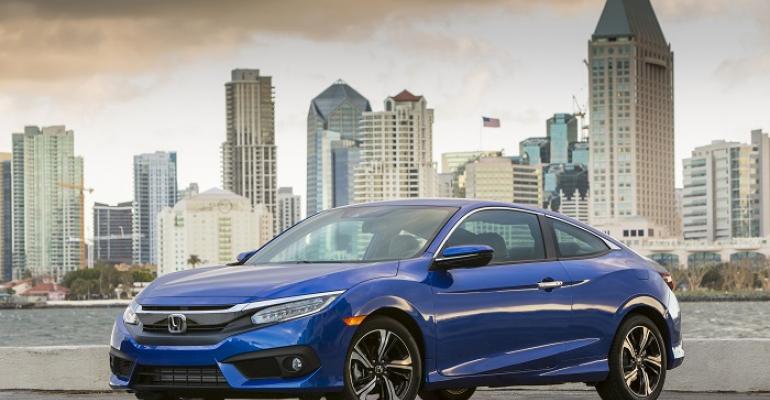Proving not everyone wants to drive a CUV, Honda’s redesigned Civic is selling like hotcakes, with sales up 29.0% through April, WardsAuto data shows.
“The car is meeting-slash-exceeding our expectations. You build a better mouse trap and people come and it’s working,” Jeff Conrad, group vice president-Honda for American Honda says of the new ’16 sedan and ’17 coupe.
Honda ended April with a 48 days’ supply of the Civic, down from 56 in March and 73 in April 2015.
The average days’ supply for domestically built Upper Small models in late April was 64, WardsAuto data shows.
But going against the adage that a new model lifts the entire segment, the clamor for the Civic isn’t benefiting the majority of the competition.
Sales in WardsAuto’s Upper Small segment, where the Civic and most of its compact competitors live, were off 6.9% in the year’s first four months.
Of the 21 nameplates in the group, only three were in the black through April. Joining the Civic in positive territory were the Kia Forte, up 26.1%, and the Nissan Sentra, rising 20.6% from like-2015.
The Forte is being sold down in anticipation of a new model this year, while the Sentra has been refreshed for ’16.
Among non-discontinued models, the worst-performing C-cars include the Chevrolet Cruze, Dodge Dart, Hyundai Elantra and Toyota Prius C.
All four models are off more than 33.0% from the first four months of 2015, with the Cruze seeing the biggest decline, 37.0%, and losing a hefty 30,000 units from year-ago.
The Cruze is new for ’16 and the Dart is set to be killed next year, while the Elantra is all-new for ’17 and the Prius C, a hybrid, is suffering the effects of low fuel prices, Toyota has said.
Despite the new Elantra, Hyundai Motor America CEO Dave Zuchowski told media in January that capacity for the car at Hyundai’s Montgomery, AL, plant is being cut this year to make way for more builds of the in-demand Santa Fe midsize CUV.
Civic Up, Corolla Down
Another model in the red is the Civic’s longtime rival, the Toyota Corolla. Corolla sales slipped 5.2% through April. The Corolla and Civic swapped No.1 and No.2 segment positions this year, with the former down to 116,371 deliveries from 122,718 year-ago and the Civic rising to 122,634 from 95,102 in January-April 2015.
As at Hyundai, there’s been more demand for Toyota CUVs. RAV4 sales climbed 18.2% through April. However, Toyota executives deny car builds will suffer as a consequence of the American buyer’s predilection for CUVs.
Corolla production in Mississippi rose 4.8% through April, while output in Cambridge, ON, Canada, was flat, up 0.9%.
The Upper Small segment’s year-to-date volume of 682,638 is a 4-year low, WardsAuto data shows.
A likely spot for most C-car defection is the Small CUV segment, up 56.6% through April. It’s composed mainly of B-platform CUVs, but with models priced similarly to C-size cars.
However, on volume the B-CUV sector has a long way to go to reach compact-car-like numbers. The 56.6% increase was on 292,080 sales vs. 186,509 year-ago.
Meanwhile, Conrad says Honda has enough Civic capacity in North America to meet demand without having to import units, something it hasn’t done in two years.
“We’ve squeezed out every last car we can,” he says of Civic production sites in Greensburg, IN, and Alliston, ON, Canada.
Honda assembled 87,782 Civics in Greensburg in the first four months of 2016, up 23.9%, while 70,337 were built in Alliston, up 18.6%.
Conrad sees Civic demand likely sliding in the fall and winter months of 2016, paralleling the usual downturn in new-vehicle sales in those cooler weather periods.
On the topic of possibly reduced overall vehicle demand in the U.S., Conrad believes that doesn’t need to equal a recession.
“Well, everybody looks at the economy and (says) recessionary dips (happen after) seven years. Well, we’re at seven years now. But that doesn’t necessarily mean that you come out and you go back into a dip,” he says, noting a 16.5-million seasonally adjusted annual rate would not be a bad drop-off from an 18-million SAAR.
However, Conrad acknowledges that even if Honda remains disciplined on production in the face of lower demand, others may not.
“We don’t follow the herd necessarily, but the herd can pull you along,” he says.





